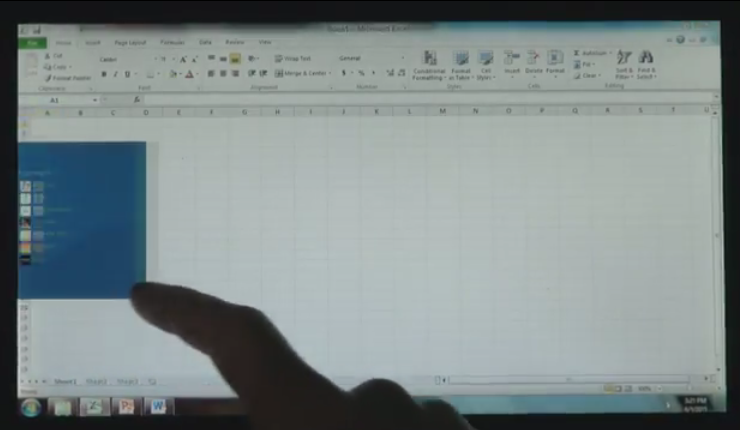I’ll admit that I was pleasantly surprised by videos and shots of Windows 8 running what is, in essence, Windows Phone 7 on a big screen. The interface is smooth, sexy, and tile-centric, thereby breaking the 1950s desktop paradigm and bringing us into an era of flat apps designed to do one or two things very well. It was what Dashboard for OS X was supposed to be if anyone ever used it.
But, a few minutes into the above video, we see Windows 8 Achilles’ heel: Windows itself. Everything is running smoothly, the touch interface seem seamless and then, like a fart in a quiet room, things change. There’s the file system. There’s Excel looking for all the world like an conservative accountant at a pick-up artists’ convention.
When you start out, you get this:

Then, when you want to get anything done, you get this:

Why upgrade then? Why not just sit on a copy of XP, as many IT departments probably still are?
While you can argue that they still have two years to make this version of Windows shine, two years is an instant at a company as big as Microsoft. It would take two years of meetings just to discuss better touch interaction with Microsoft Excel’s SUM() function let alone rebuild the entire Office suite from the ground up. Microsoft is stuck.
The same thing happened with Windows Mobile. When it arrived on the scene it was arguably the best smartphone OS out there. Then Linux hackers discovered that they could run lots of cool things on their iPaqs, Nokia went Symbian, and Palm pounded out a few versions before going belly-up. In short, people had alternatives to Windows.
But Microsoft never saw the alternatives. They were invisible. WinMo kept accreting shells and new UIs and slight improvements and, in the end, it looked like that selfsame fart in a quiet room: you’re tooling along, using “new” apps, and suddenly you dump into an interface that looks like a WAP web page.
There were alternatives to this, but Microsoft didn’t see them.
I don’t think Microsoft engineers think in those terms. When you’re building a huge, popular product, the rest of the industry are mere flies on your backside. But once the Mobile team realized that iOS was eating their lunch, Windows Phone 7 started to become a reality. I personally love Windows Phone 7. It is rebuilt with the 21st century in mind and, although it is still in its infancy, it will be a powerhouse in the mobile market sooner than later. Windows needs the same attention paid to it.
As DaringGruber writes:
But I think it’s a fundamentally flawed idea for Microsoft to build their next-generation OS and interface on top of the existing Windows. The idea is that you get the new stuff right alongside Windows as we know it. Microsoft is obviously trying to learn from Apple, but they clearly don’t understand why the iPad runs iOS, and not Mac OS X.
…
The ability to run Mac OS X apps on the iPad, with full access to the file system, peripherals, etc., would make the iPad worse, not better. The iPad succeeds because it has eliminated complexity, not because it has covered up the complexity of the Mac with a touch-based “shell”. iOS’s lack of backward compatibility with any existing software means that all apps for iOS are written specifically for iOS.
I think the key word there is “shell.” I’ve seen plenty if ill-fated touchscreen interfaces from HP, Dell, and the like and thus far none of them have gained any traction. If Microsoft was serious about replacing icons with tiles, they’d have done it. If they were thinking seriously about a tablet version, they’d smarten up Windows Phone 7 rather than dumbing down Windows Vista. We have a proven method for success. They just won’t apply it.
We can armchair quarterback this all we want, arguing on both sides of the spectrum (“Apple Did It Great!” vs. “John Biggs Is a Douche!”) but I’m not asking Microsoft to become Apple. I’m asking them to look at a successful platform and emulate it. We have enough engineering prowess at most of these companies to enter a new era of PC interaction. We don’t need a simulacrum of the new era bolted on top of code that should have been retired years ago.